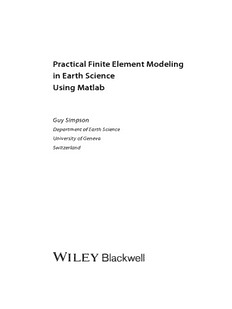
Practical Finite Element Modelling in Earth Science using MatLab PDF
Preview Practical Finite Element Modelling in Earth Science using MatLab
Practical Finite Element Modeling in Earth Science Using Matlab GuySimpson DepartmentofEarthScience UniversityofGeneva Switzerland Thiseditionfirstpublished2017©2017JohnWiley&SonsLtd LibraryofCongressCataloging-in-Publicationdataappliedfor ISBN:9781119248620 BriefContents Preface xiii Symbols xv AbouttheCompanionWebsite xvii PartI TheFiniteElementMethodwithMatlab 1 1 Preliminaries 3 2 BeginningwiththeFiniteElementMethod 13 3 ProgrammingtheFiniteElementMethodinMatlab 25 4 NumericalIntegrationandLocalCoordinates 35 5 TheFiniteElementMethodinTwoDimensions 49 6 TheFiniteElementMethodinThreeDimensions 67 7 GeneralizationofFiniteElementConcepts 81 PartII ApplicationsoftheFiniteElementMethodinEarthScience 119 8 HeatTransfer 121 9 LandscapeEvolution 137 10 FluidFlowinPorousMedia 151 11 LithosphericFlexure 167 12 DeformationofEarth’sCrust 183 13 GoingFurther 207 AppendixA DerivationoftheDiffusionEquation 217 AppendixB BasicsofLinearAlgebrawithMatlab 221 AppendixC ComparisonbetweenDifferentNumericalMethods 227 AppendixD IntegrationbyParts 237 AppendixE TimeDiscretization 239 References 241 Index 245 Contents Preface xiii Symbols xv AbouttheCompanionWebsite xvii PartI TheFiniteElementMethodwithMatlab 1 1 Preliminaries 3 1.1 MathematicalModels 3 1.2 BoundaryandInitialConditions 4 1.3 AnalyticalSolutions 5 1.4 NumericalSolutions 5 1.5 NumericalSolutionMethods 7 1.6 MatlabScript 8 1.7 Exercises 10 SuggestedReading 12 2 BeginningwiththeFiniteElementMethod 13 2.1 TheGoverningPDE 13 2.2 ApproximatingtheContinuousVariable 14 2.3 MinimizingtheResidual 15 2.4 EvaluatingtheElementMatrices 17 2.5 TimeDiscretization 18 2.6 Assembly 19 2.7 BoundaryandInitialConditions 21 2.8 SolutionoftheAlgebraicEquations 21 2.9 Exercises 22 SuggestedReading 23 3 ProgrammingtheFiniteElementMethodinMatlab 25 3.1 ProgramStructureandPhilosophy 25 3.2 SummaryoftheProblem 25 3.3 DiscretizedEquations 26 3.4 TheProgram 27 3.4.1 PreprocessorStage 27 3.4.2 SolutionStage 29 3.4.3 PostprocessorStage 30 3.5 MatlabScript 30 3.6 Exercises 33 SuggestedReading 34 4 NumericalIntegrationandLocalCoordinates 35 4.1 Gauss–LegendreQuadrature 36 4.2 LocalCoordinates 37 4.3 EvaluatingtheIntegrals 39 4.4 VariableMaterialProperties 40 4.5 ProgrammingConsiderations 41 4.6 MatlabScript 43 4.7 Exercises 45 SuggestedReading 47 5 TheFiniteElementMethodinTwoDimensions 49 5.1 Discretization 50 5.2 GeometryandNodalConnectivity 52 5.3 IntegrationofElementMatrices 54 5.4 MultielementAssembly 57 5.5 BoundaryConditionsandSolution 60 5.6 MatlabScript 61 5.7 Exercises 65 SuggestedReading 66 6 TheFiniteElementMethodinThreeDimensions 67 6.1 Discretization 67 6.2 ElementIntegration 69 6.3 AssemblyforMultielementMesh 72 6.4 BoundaryConditionsandSolution 73 6.5 MatlabProgram 74 6.6 Exercises 79 SuggestedReading 80 7 GeneralizationofFiniteElementConcepts 81 7.1 TheFEMforanEllipticProblem 84 7.2 TheFEMforaHyperbolicProblem 96 7.3 TheFEMforSystemsofEquations 102 7.4 Exercises 116 SuggestedReading 116 PartII ApplicationsoftheFiniteElementMethodinEarthScience 119 8 HeatTransfer 121 8.1 ConductiveCoolinginanErodingCrust 122 8.2 ConductiveCoolingofanIntrusion 126 SuggestedReading 135 9 LandscapeEvolution 137 9.1 Evolutionofa1DRiverProfile 138 9.2 EvolutionofaFluviallyDissectedLandscape 143 SuggestedReading 150 10 FluidFlowinPorousMedia 151 10.1 FluidFlowAroundaFault 152 10.2 ViscousFingering 157 SuggestedReading 166 11 LithosphericFlexure 167 11.1 GoverningEquations 167 11.2 FEMDiscretization 168 11.3 MatlabImplementation 171 SuggestedReading 181 12 DeformationofEarth’sCrust 183 12.1 GoverningEquations 183 12.2 RateFormulation 185 12.3 FEMDiscretization 186 12.4 Viscoelastoplasticity 188 12.5 MatlabImplementation 190 SuggestedReading 205 13 GoingFurther 207 13.1 Optimization 207 13.2 UsingOtherFEMs 213 13.3 UseofExistingFiniteElementSoftware 215 AppendixA DerivationoftheDiffusionEquation 217 AppendixB BasicsofLinearAlgebrawithMatlab 221 AppendixC ComparisonbetweenDifferentNumericalMethods 227 AppendixD IntegrationbyParts 237 AppendixE TimeDiscretization 239 References 241 Index 245 Preface Over the past few decades, mathematical models have become an increasingly important tool for Earth scientists to understand and make predictions about how our planet functions and evolves throughtimeandspace.Thesemodelsoftenconsistofpartialdifferentialequations(PDEs)thatare discretizedwithanumericalmethodandsolvedonacomputer.Themostcommonlyuseddiscretiza- tionmethodsarethefinitedifferencemethod(FDM),thefinitevolumemethod,thefiniteelement method (FEM), the discrete element method, the boundary element method, and various spectral methods.Intheory,eachmethodprovidesthesamesolutiontotheoriginalPDEs.However,inprac- tice,certainmethodsarebettersuitedtocertainproblemsthanothers.Often,onemethoddominates withinanygivendisciplineandintheEarthsciences,theFDMisthemostprevalent,duetoitssim- plicity.AlthoughtheFEMisarguablybettersuitedtomanyEarthscienceproblems—especiallythose withcomplicatedgeometryand/ormaterialbehavior—Earthscientistshavebeenhesitanttowhole- heartedlyembracethistechniquebecauseitisregardedasbeingcomplicatedtoimplementcompared tootherschemes.However,thisperceiveddifficultylargelyreflectsthefactthatmosttextbookson thismethodarewrittenbyengineersormathematiciansforengineerswhohaveadifferenteduca- tionalbackgroundascomparedtoEarthscientistsandwhoareinterestedindifferentapplications. ThisisunfortunatebecausetheFEMisaremarkablyflexibleandpowerfultoolwithenormouspoten- tialintheEarthsciencesthatisnomoredifficult(oreveneasier)toimplementthanothernumerical schemes. ThetextisintendedforstudentsandresearchersinEarthscience,attemptingtheirfirststepswith theFEM.ItprovidesapracticalguideonhowtheFEMcaneasilybeusedtosolvevariousEarthsci- enceproblemsusingMatlab.Forthemostpart,Iassumethattheequationsgoverningtheprocesses ofinterestareknown.EmphasisisonhowoneactuallycomputesthesolutionusingtheFEM.Thetext doesnotdealindetailwithbenchmarkingandinterpretationofmodelresultsorwithapplicationof themodelresultstospecificcasestudies.Toguidereaders,manysamplefiniteelementMatlabscripts arepresented.Thesescriptsarewrittenwithanemphasisonsimplicityandclarity,notonmodularity andefficiency.However,oncetheunderlyingconceptsareclear,thesestandalonecodescouldeas- ilybemodularized,optimized,andtransportedtoothermoreefficientlanguagessuchasFortranor C/C++.ItisassumedthatthereaderisfamiliarwithlinearalgebraandPDEsandhasbasicprogram- mingexperience.SomeoftheseaspectsarecoveredbrieflyinChapter1andAppendixB.Thetextis directedtowardgraduatestudents,advancedundergraduates,andEarthscienceresearchers.While thetextisintendedtoshowhowfiniteelementprogramscanbewrittenfromscratch,itshouldalso beofinteresttoresearcherswhouseexistingFEMsoftware(e.g.,ABAQUSandCOMSOL)butwho wanttoknowmoreaboutwhatgoesonwithinthe“blackbox”.Becausethelevelofthematerialpre- sentedisquitebasiccomparedtootherfiniteelementtexts,readersarestronglyadvisedtoconsult othermoreadvancedbooksoncetheyunderstandthebasicsandseehowprogramsareconstructed inpractice.Thefollowingtitlesaregoodstartingpoints:TheFiniteElementMethod(threevolumes, byZienkiewiczandTaylor,2000a,b,c)andTheFiniteElementMethod(byHughes,2000). This book is structured in two parts. Part I begins with a general introduction to numerical modelingbeforepassingtoaseriesofchaptersthatshowhowanarchetypicalmathematicalmodel (i.e., the diffusion equation) is discretized with the FEM, programmed in Matlab, and solved on a computer.Eachchapterbuildsonthepreviousoneandintroducesone(ormore)keyaspectofthe FEM.Chapter7generalizestheconceptsintroducedinChapters1–6byshowinghowtheFEMcan extendedfromsingleparabolicequationstosystemsofequationsandalsotoellipticandhyperbolic equations.BytheendofPartI,thereadershouldunderstandtheessentialsoftheFEMandbeable to write their own Matlab scripts from scratch to solve the most commonly encountered PDEs in onedimension(1D),twodimension(2Ds),andthreedimension(3Ds).Thismaterialcanbetaught asaonesemestercourseonnumericalmodelinginEarthscienceformasterandPhDstudents.Part IIcomprisesaseriesofindependentchapters,eachofwhichfocusesonhowtheFEMcanbeapplied in different contexts in Earth science. The problems investigated are heat transfer in the crust, landscapeevolutionmodeling,fluidflowinporousmedia,flexure,anddeformationofEarth’scrust. Although readers can choose to read only the chapter(s) that fall closest to their topic of interest, each chapter introduces a different aspect of the FEM, and so every chapter should be studied by readersinterestedineventuallymasteringthetechnique. I am very much indebted to Yuri Podladchikov who initially inspired my interest in the subject presentedandwhocontributedinamajorwaytomyunderstandingoftheFEM.Duringthesame period, I also benefited enormously from discussions and interaction with many other colleagues fromtheETHinZurich,including,inparticular,AlanThompson,JamieConnolly,NeilMancktelow, Jean-PierreBurg,SteveMiller,LuigiBurlini,KatjaPetrini,TarasGerya,StefanSchmalholz,Daniel Schmid,BorisKaus,andDaveMay.LineProbstfromtheUniversityofGenevaisthankedformany comments and corrections on the text. I gratefully acknowledge financial support for my research fromtheSwissNationalScienceFoundation,theDepartmentofEarthScienceattheUniversityof Geneva,andtheSchmidheinyFoundation.Finally,Ithanktheencouragementandsupportfrommy parents,mywifeKatja,andmychildrenLuca,Lara,andFabio. GuySimpson Geneva Symbols Matlabvariable Dimensions Description b [sdof, 1] Globalright-hand-sidevector bee [nst, ntot] Kinematicstrain—displacementmatrix bcdof [1 ndn] ArraycontaininglistofequationswhereDirichlet boundaryconditionsareimposed ndn scalar NumberofequationstowhichDirichletconditions areapplied bcval [1 ndn] Arraycontainingfixedboundaryvalues bx0 [1 ny]in2D Arrayscontaininglistofnodesonx=0boundary bxn [1 ny]in2D Arrayscontaininglistofnodesonx=lxboundary coord [nod, ndim] Nodecoordinatesforoneelement dee [nst, nst] Materialdeformationmatrix der [ndim nod] Derivativesofshapefunctionsinlocalcoordinates, evaluatedatanintegrationpoint der_s [ndim nod nip] Derivativesofshapefunctionssavedforall integrationpoints deriv [ndim nod] Derivativesofshapefunctionsinglobal coordinates,evaluatedatanintegrationpoint detjac scalar DeterminantoftheJacobianmatrix displ [sdof, 1] Globalsolutionvector displ0 [sdof, 1] Globalsolutionvectorfromprevioustimestep dt scalar Timeincrement dx scalar Elementdimensioninthex-direction F [ntot, 1] Elementloadvector ff [sdof, 1] Globalright-hand-sideloadvector fun [1 nod] Shapefunctions,evaluatedatanintegrationpoint fun_s [nip nod] Shapefunctionssavedforallintegrationpoints g [ntot 1] Equationlistforoneelement g_coord [ndim nn] Nodecoordinatesforentiremesh g_g [ntot nels] Equationnumbersofeachelementforentiremesh g_num [nod nels] Nodenumbersofeachelementforentiremesh invjac [ndim, ndim] InverseoftheJacobianmatrix jac [ndim, ndim] Jacobianmatrix KM [ntot, ntot] Elementstiffnessmatrix
